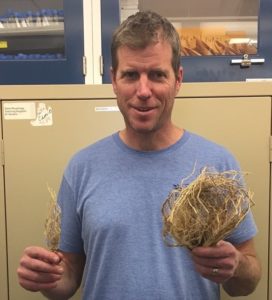
When studying plants, sampling the above-ground parts we are all familiar with, such as leaves, flowers, and seeds, is the norm, in part because it is much easier to sample thousands of leaves and stalks, rather than digging up thousands of plants to analyze roots. Now, the Department of Energy’s Advanced Research Projects Agency-Energy has awarded $6.1 million to a group led by Colorado State University to do just that – learn about plant genetics from exploring plant roots as well as the soil around the plants.
John McKay, an associate professor in CSU’s Department of Bioagricultural Sciences and Pest Management, will lead the project – Rhizosphere Observations Optimizing Terrestrial Sequestration (ROOTS) – which will automate the phenotyping of plant roots in agricultural fields and allow researchers to learn more about the genetic composition of the plants based on their roots.
Getting to the root of the matter
“This grant will allow us to scale up our research and look at roots in thousands of research plots and millions of plants,” said McKay. “Previously, we were limited by the number of plants we could harvest by hand which meant we lacked the power to identify genes underlying important variation in root traits, including the ideal root systems for maximizing water and nutrient use efficiency.”
The project will employ two different approaches – pulling the plants out of the ground using a machine currently deployed to examine above-ground material and examining the soil around the plants by using novel, automated sampling the soil throughout the growing season. The researchers are interested in learning which nutrients each plant genotype is using and how much carbon remains in the soil.
Impact of droughts
One of the project’s intended outcomes is to evaluate the role of roots in areas impacted by droughts. Because roots are not photosynthetic, breeders inadvertently select against robust, drought tolerant root systems if breeding takes place in optimal production environments.
“With the exception of resistance to root pests, very little effort has been invested in trying to understand the genes that underlie root variation in the major crops. Here, we will combine best practices in the genetics of complex traits, with novel technology and modeling to accurately capture variation in root traits and predict their effects on soil,” said McKay.
Three-year project
The three-year project will begin by looking at corn, although McKay thinks that the technology and findings developed by the team will benefit other crops. McKay will lead the team that includes researchers from Iowa State University, the University of Arizona, the Danforth Center for Plant Sciences, C-Zero, and USDA-ARS in Arizona with support from the Colorado Corn Growers.
For more information on the project, visit the website.